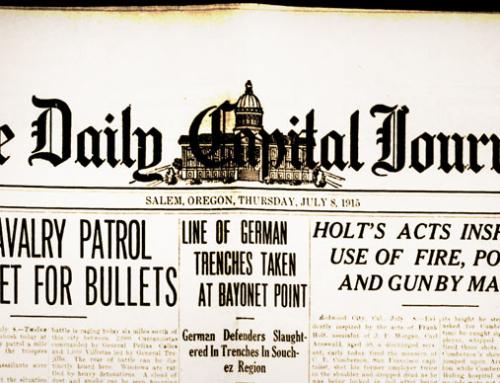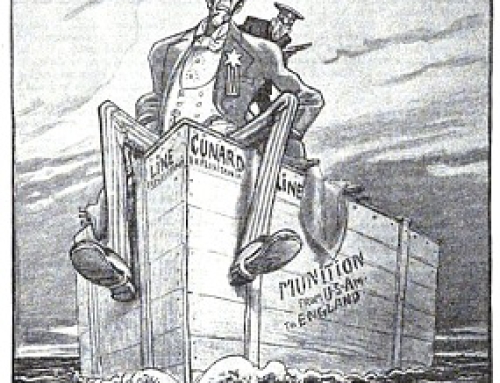by Richard van Pelt, WWI Correspondent
From the front page of the Capital Journal:
FRANK’S SENTENCE COMMUTED TO LIFE IN PRISON TODAY
Noted Prisoner Will Not Pay Death Penalty For the Phagan Murder
GOVERNOR SLATON SAVES MAN IN SHADOW OF NOOSE
Angry Crowds Gather When News of Reprieve Is Spread About Town
The travesty of Leo Frank is beyond the scope of these chronicles. In August, Leo Frank would be lynched by a mob convinced that the trial, in all respects a parody of the judicial process, represented the proper expression of the general mood of the people. The process of justice results in a just outcome only when the outcome conforms to prejudice of the community.
BRITISH ACCUSED OF USING AMERICAN FLAG AS DISGUISE
Germans Charge English With Flying Neutral Flag On Ammunition Packets
MAY FORM BASIS FOR ANSWER TO REJOINDER
Report Asked From Ambassador Page In London Not Yet Received
Washington, June 21. – Serious charges of abuse of the American flag by the allies have been made to the state department by Germany, it was learned today.
The charges filed covered at least six instances in which use of the flag was abused within the past two months. A report has been asked from the American embassy in London, but nothing has yet been heard from Ambassador Page.
It was learned authoritatively today that Germany has also cited the flying of other neutral flags by disguised British ships combing the seas for German submarines. These charges, it is expected, will figure in Germany’s reply to President Wilson’s latest note regarding the submarine warfare. The position will be taken that with the allies using such methods it is impossible for submarine commanders to observe ordinary usages and operate in accordance with the international rules of visit and search before sinking suspected vessels.
The State Department has already been informed of Germany’s charge that the submarine U-29 was rammed and sunk by a British tank steamer flying the Swedish flag. Advantage was taken of the opportunity for attack afforded when the submarine commander asked that the tanker show her papers, the Germans charge. This is denied by the British admiralty, which has declared the U-29 was sunk by a warship, and officials here are puzzled how Germany was informed of the manner in which the submarine was sunk if the crew perished.
The charges and counter-charges built a case that resulted in the German policy of unrestricted U-Boat warfare later in the war. The German charge that the U-29 was rammed by a British ship flying a false flag is an example of misdirection. The U-29 was rammed and sunk by the HMS Dreadnought on the 18th of March, 1915, the only known instance in which a submarine was sunk by a battleship.
The Oregon Statesman’s editorial poignantly asks “How Long Will They Last?
As the war drags on without any decrease of intensity or any promise of the end, military experts are figuring on how long the available supply of human material will last. The latest casualty reports give a pretty good basis of computation.
The British dead, wounded and missing up to May 31 numbered 258,000. The total had almost doubled in seven weeks, and the figures will run up still more rapidly as the army is brought to its full strength and assumes its share of the fighting.
Serbia has lost about an equal number of men. Belgium’s losses are given as about 200,000. German casualties are estimated by careful observers at perhaps 2,225,000. There can be little doubt that German and Austrian losses together up to the end of May aggregate at least 3,000,000. Russia’s losses are thought to be about 2,300,000, those of France 1,500,000 and those of the Turks, South Africans, East Africans and others 100,000.
This gives a grand total of 7,500,000. It is reckoned that about 1,500,000 have been killed, 4,500,000 wounded and the rest – given as “missing” – are for the most part prisoners of war. Russia particularly has lost an enormous number of men as prisoners.
The estimate means that for the first ten months of the war the average loss has been 750,000 a month. It is easy to see that but little more than two years of such warfare – say until the fall of 1916 – will eliminate all the regular military forces existing in the belligerent countries when the war began. After that, if the war continues, they would depend on their “unorganized strength,” consisting of all the men of any age able to perform military duty in extreme need. That would provide enough men to keep the death mill grinding for three years longer. Then, in theory, there wouldn’t be a single able-bodied man left in any of the warring countries.
Of course, this reckoning takes no account of the large numbers of wounded men who return to the front after convalescence, and of the missing who rejoin their colors or appear in later lists and so are counted twice. The growing fierceness of the struggle, however, in the next few months may more than balance whatever discount must be allowed to these particulars.
Seven hundred and fifty thousand men a month – thus the manhood of Europe is being cut down by bullet, bayonet and shrapnel, every victim suffering keen pain and leaving a train of anguish and grieving for a man killed, wounded or lost. Seven hundred and fifty thousand strong male bodies swept away in fire and blood, and another 750,000 coming forward to take their places.
How long can Europe stand it?
The paper’s editorial is an ironic contrast to the same paper’s editorial, “Painless Shooting” from its September issue:
It is a pleasure to be able to specify one particular in which war has become less horrible. Getting shot is far less painful and dangerous than it used to be.
The lead bullets of our civil war, that used to spread making great, jagged wounds and splintering bone beyond surgical hope, are gone now. There has been some mention of “dum-dum” bullets being used by certain German troops in Belgium, but that report is hardly credible. The “dum-dum” had a steel-cased body and soft nose. It “mushrooms” in the flesh, or even in the air before it strikes, and lacerates a man so quick death or deadly gangrene is almost inevitable.
All the civilized nations now use rifles of small bore and great power, firing bullets encased in steel or nickel. These missiles have such velocity that they usually bore through flesh and bones, making a hole so small and clean that there is little blood lost unless an artery is cut. The heat of the bullet, caused by its speed, makes it cauterize its own wound, so that there is slight peril of infection.
A soldier is killed only if hit in a mortal spot, and the number of such spots has greatly decreased. A wounded man is generally disabled for a few days or weeks, but many of the participants in recent battles have fought for hours without knowing they were hit.







Leave A Comment